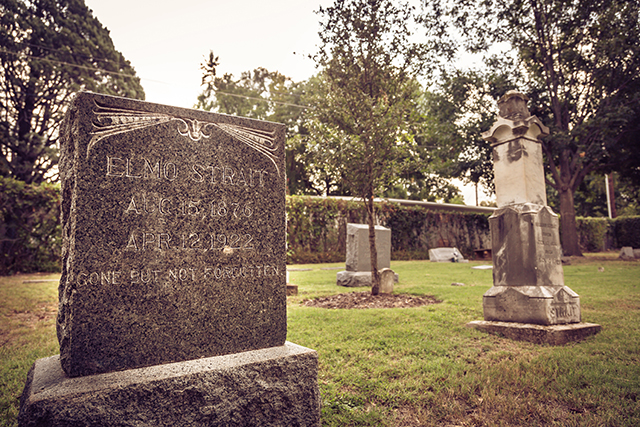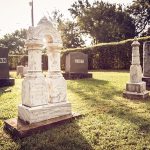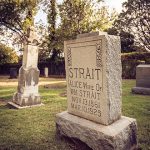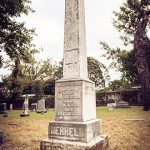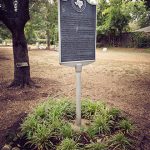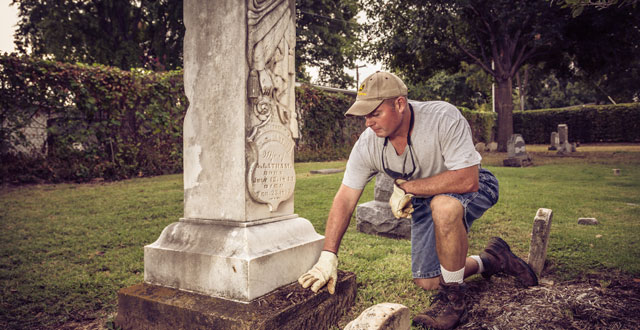
Preston Hollow resident Randy Griffin is the caretaker of Merrell Cemetery: Photo by Jennifer Shertzer
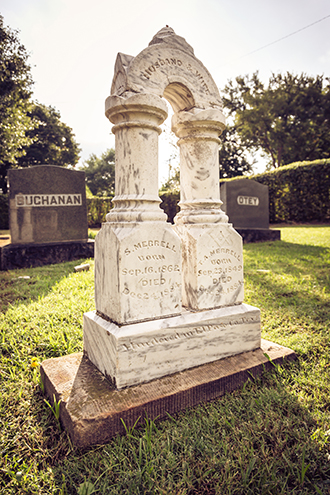
Husband and wife S. and T. A. Merrell were murdered in El Paso on Christmas Eve, 1884. Photo by Jennifer Shertzer
About once a week, Randy Griffin drives his utility truck one street over from his Preston Hollow home to the historic, family cemetery in the 4000 block of Merrell Road.
He keeps the grass green and trimmed, protects against vandals, and watches over the graves and their curious mementos. He makes sure that the golf ball remains at the right side of John Crump Spicer, and that the dusty Dr Pepper bottle stays tucked behind Mark Allen Durham.
“My wife thinks it’s an odd deal that I’m out here doing this,” says Griffin, a professional landscaper who has worked on large commercial projects at the Galleria and Medical City. “I enjoy the place. I love taking care of it.”
What began as just another landscaping job grew into a lasting dedication. Griffin now serves as board president of the Merrell Cemetery Maintenance Association. He buried his mother there in 2011 among the pioneers of Dallas.
Before the city developed around it, Merrell was a one-lane country road leading from Midway straight to the cemetery, established in the late 1840s. It contains names recognizable to anyone who has driven the streets of Preston Hollow: Strait, Welch, Coppedge and Marsh, to name a few.
According to historian A.C. Green’s paper, “History of the Merrell Cemetery,” the burial ground sat on the Benjamin Merrell Survey, a piece of land obtained as a grant from the Texas Emigration and Land Co. also known as the Peters Colony. Eli Merrell, the cemetery’s namesake, was the first marked grave in 1849. The minister and his wife, Mary, settled on 640 acres near Bachman Creek. Nearby lies his nephew, Benjamin Merrell, Dallas County’s first tax collector, a title proudly engraved on the headstone. A few steps behind it, though, a small, crudely carved stone marker reads, “Ben Merrell,” likely a temporary headstone that never was removed, Griffin says.
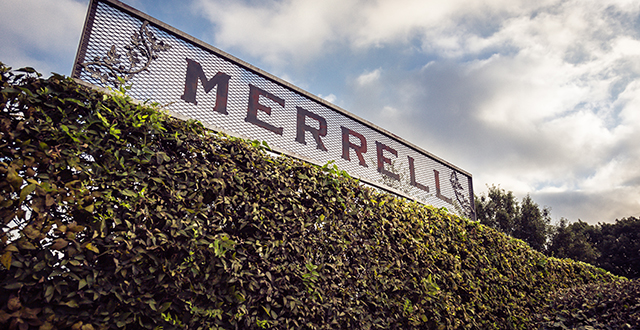
Merrell Cemetery is a pioneer burial ground that existed long before our neighborhood sprouted up around it. Photo by Jennifer Shertzer
Another pioneer family, the Straits, rests in the cemetery, including the son, Elmo Strait, who became the seventh Dallas Police Chief in 1921 before he died suddenly a year later at age 46 (read more about Elmo Strait and the Dallas Police Museum on page 10).
Stories abound at Merrell Cemetery, including that of husband and wife T.A. and S. Merrell, whose marble tombstone reads, “Murdered in El Paso Co. Tex.” Both died young on the same day, Christmas Eve, 1884. No one knew why until 15 years ago when Dallas Morning News columnist Steve Blow unraveled the mystery: the newlyweds had settled on a ranch outside of El Paso, but just two months later the wife was found decapitated and laying next to her husband who had an axe in his skull. Two hired ranch hands were suspected of the murders, but it’s unclear whether they were arrested.
Even after his 20 or so years of maintaining the grounds, Griffin still is learning the histories of each grave from Merrell Cemetery’s aging membership.
“I was the youngest when I started, and I’m still the youngest,” he says.
In addition to grounds keeping, Griffin also serves as sexton and funeral director, mapping out each plot and ensuring its inhabitant receives the best care possible. Ironing out the details can be a bit nerve-wracking for a landscaper who never intended to supervise the burial process, he says. When he began doing so in the early-2000s, he’d often wake up in the middle of the night before the service, re-thinking whether the person wanted to be buried on the right side or the left side of the deceased loved one. Now, he knows the system by heart.
“I’m reassuring them they’ll be where they want to be. I’ve buried a lot of people here. People I’ve known.”
All his work and friendships with the elderly relatives of the pioneer families means he inevitably will watch them pass away, and coordinate their burials, one of the most recent being Mary Cook, an esteemed board member who lived to be 103 years old. Her family’s farm sat at the southwest corner of Walnut Hill and Midway where St. Monica’s exists today.
“I really value hearing from older people,” Griffin says. “A lot of that is just talked about and never written down.”
Merrell Cemetery Maintenance Association board of trustees formed in 1965 to raise funds for improvements as needed and, to deter vandalism, the cemetery remains locked at all times, with Griffin as the gatekeeper.
Strange as it may seem for a landscaper to spend so much time working around the dead, Griffin takes pride in it.
“It’s a process of life. I’ll be doing it with myself when the time comes.”
And when that time comes, he’ll lie in Merrell Cemetery.
For more information, visit merrellcemetery.com.


